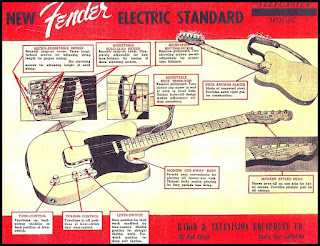Introduction
If you remember back in my first post, I mentioned the bridge pickup routing had been enlarged. I was hoping that the bridge I bought would cover it (and it does), but one thing that was really bothering me was that it seemed to be in the wrong place. |
| Comparing dimensions (Fender on the left) |
This is probably going to make tuning and intonation impossible.
A Closer View
I was a bit annoyed, so I messaged the vendor on Ebay. He sent me photos of the old bridge he'd taken off it, and it seemed to match the one I'd bought. Maybe it will work, but until the neck had arrived I didn't know for sure. |
| The photo from the vendor |
My bridge has the same dimensions and those mounting holes match exactly.
 |
| My bridge showing the measurement from the nut. |
Not a huge problem you might say, just drill new holes and mount it in the right place?
Yeah, but that will uncover that ugly botched hole!!
Filling the Hole
There was no choice if I wanted it to work properly, the bridge has to be in the right place and I needed to replace the missing wood from the body. Here's the steps I took:-
- Make a paper template.
- Glue template onto pine block (soft wood is easier to work with).
- Cut out and sand into a close fitting shape.
- Remove copper foil from the hole and glue block in with PVA.
- Repeat with a piece of thin ply with a similar grain to the body veneer.
- Stain a golden colour (I used a mix of coriander and tea).
- Apply four coats of varnish.
 |
| Left the completed body repair, right with bridge and pickguard fitted. |
Fitting the Bridge
I used the "fit the two E strings" method to position the bridge, ensuring the strings sat in the right nut slots. I pulled the strings tight, ensuring the gap to the fret board edges is the same both sides and the bridge was square. It took me a few attempts before I was happy, so if you're doing this, double check before you start drilling holes.
Once that was done, I couldn't resist throwing some strings on and trying it out.






